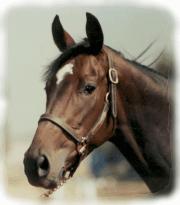A Horse, of Course with Don Blazer |
If you enjoy learning about horses, then you'll love our online courses. Each month you'll find a new column on our web site. We hope you'll enjoy it, and maybe e-mail us with questions or suggestions for other columns. A Horse, Of Course is a monthly column syndicated by Success Is Easy. If you like the column, call your local newspaper, or local horse publication and ask them to subscribe by contacting Success Is Easy. |
The Equus Family Horses, Donkeys and Mules Don Blazer copyright©2011 They've cloned horses; a practice I'm totally against. I'm not against science learning new things and trying to make life better. I'm against the suggestion that a cloned horse is the same as the original…..it isn't! A horse is made up of chromosomes and genes, highly influenced by environment; no cloned horse has experienced the same environment as the original, so they won't be the same. And it's especially good if during the process they don't lose a chromosome. The difference between Triple Crown winner Secretariat and a mule is a single chromosome and no homologous pairs. In cloning terms, "That isn't much." In scientific terms-which don't give you a clue as to the difference between a mule and a horse-the difference is simply that the horse cells have a total number of 64 chromosomes in 32 pairs that can be arranged in eight groups. The mule, however, has 63 chromosomes, not arranged in homologous (similar) pairs. Had Secretariat had 62 chromosomes, in 31 pairs, arranged in six groups, he would have been a donkey, and then winning the Kentucky Derby would have been really spectacular. To understand more about the mule, the hinny, the donkey and the burro, keep in mind that Equus asinus is an ass (or, more commonly, a donkey or burro) and Equus caballus is a horse. Now here's an interesting part about messing with chromosomes, etc.; when you cross a male ass (Jack) with a female horse, you get a mule. But when you cross a male horse with a female ass (Jenny) you get a hinny. A mule and a hinny supposedly cannot reproduce, but….so much for science…there are many recorded cases of Molly mules having foals. The exact science in the maintenance of sterility by hybrid mammals has not fully been demonstrated, as undoubtedly there are many factors involved. An interesting legend accompanies the cross that appears on the back of many donkeys and mules. It is said the donkey ridden into Jerusalem by Jesus Christ followed him to the crucifixion, and the sun's casting of the shadow of the cross on the donkey's back made a permanent mark to be noted on donkeys forevermore. The cross on the donkey's back is described in written works appearing only after Christ's crucifixion. The great work mules of the late 1700s and early 1800s contributed significantly to America's agriculture success. George Washington, first American president, was also the first recorded breeder of mammoth mules. Washington had great faith in the draft mule, and said on many occasions, "The mule is essential for America's future development." History proves he was correct. Washington had a number of huge jacks standing at stud at Mount Vernon, but his favorite was Royal Gift, a large, black Catalan ass presented to him as gift from the Spanish throne. The interest in the breeding of mules and using them for sport and recreation is still high today. Now we even have sanctioned mule racing. In fact, the only "cloned" individuals (supposedly identical) to race against each other, that I know of, were mules. Guess what….they did NOT finish in a dead heat. They may be "clones" and they may be missing the same chromosome, and they certainly aren't horses, but they are definitely their own special creatures. |
